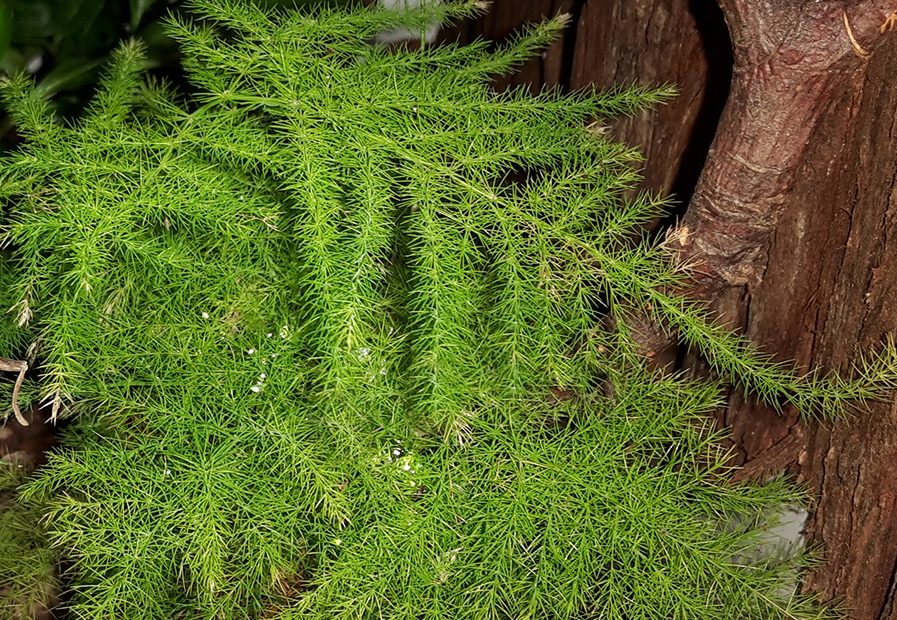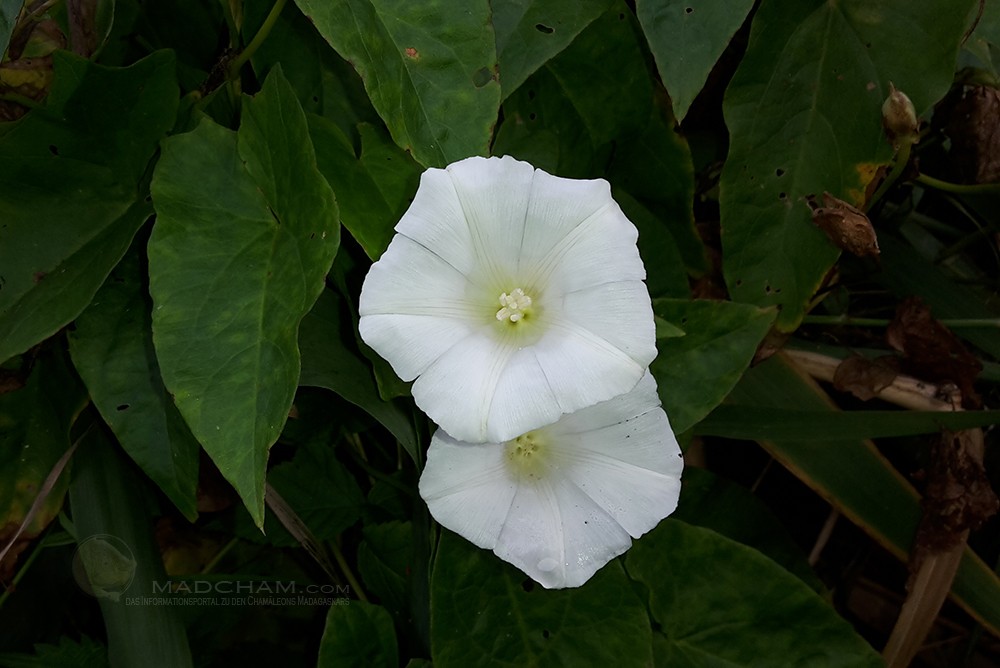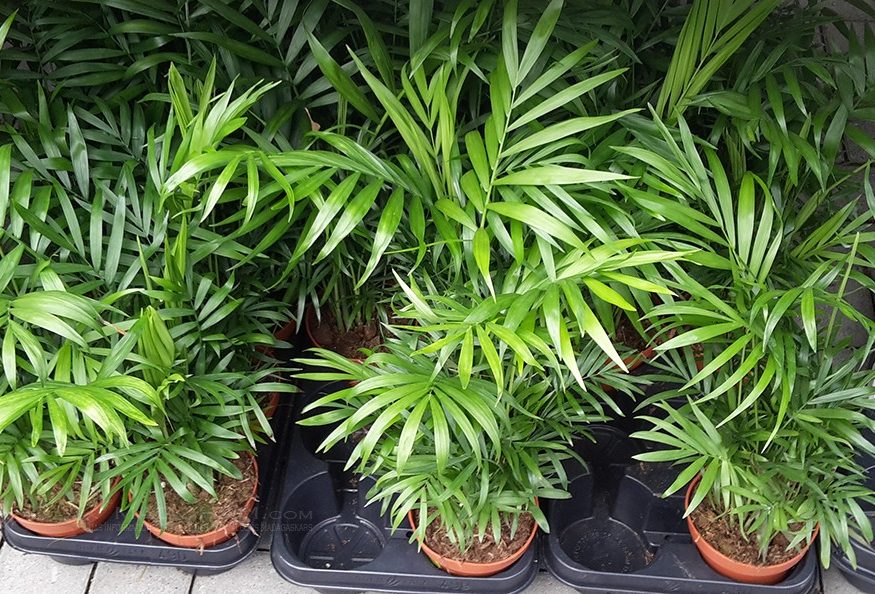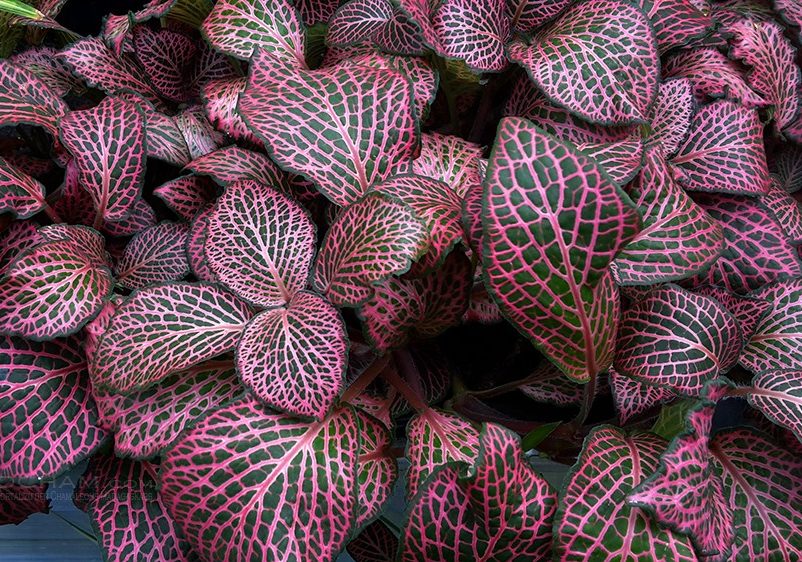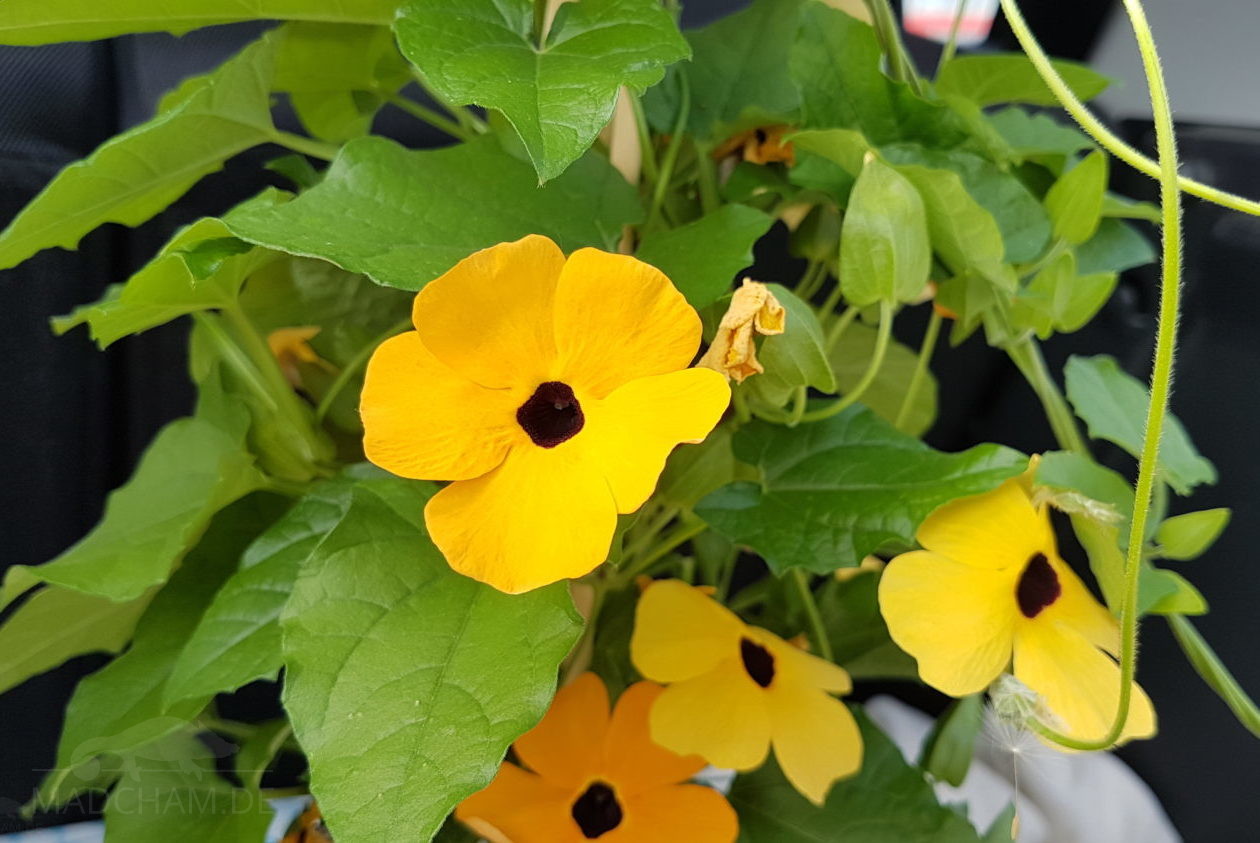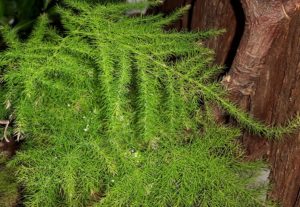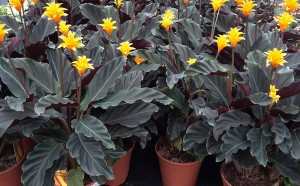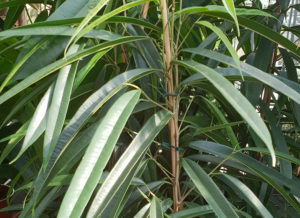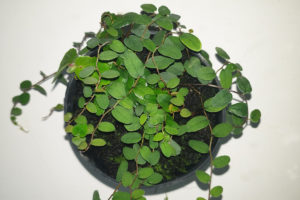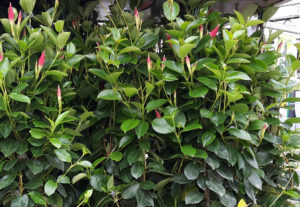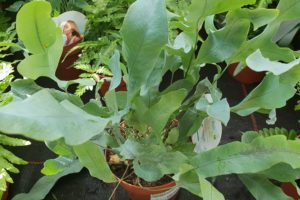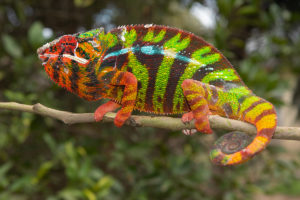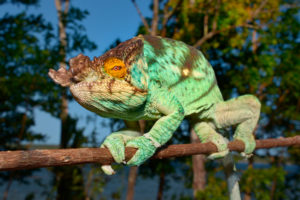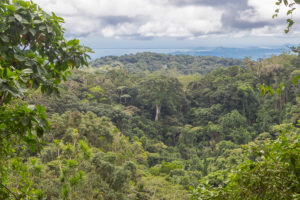Here we have compiled an alphabetic list of plants that are suitable for various chameleon terrariums. However, some of them contain potentially toxic substances, so these should not be used for those chameleons that often eat plants. Only non-toxic plants should be used for such animals. Live plants are always preferable to artificial plants because they provide a better climate. Plastic plants, on the other hand, do not maintain the necessary humidity and cannot inadvertently be swallowed by the chameleon, but in the worst case cause blockages or injuries to the gastrointestinal tract.
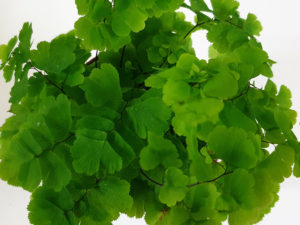
Adiantum capillus-veneris (Southern maidenhair fern)
This small-leaved fern grows well on half-shaded, evenly lit places in the terrarium. It likes humus-rich, moist soils. The roots must not dry out, otherwise the fern will die quickly. For small chameleons this fern is a good visibility protection in the terrarium. The leaves also hold water drops well.
![]() non-poisonous
non-poisonous
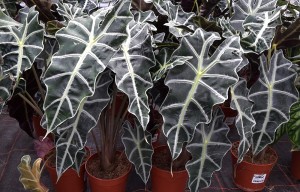 Alocasia sanderiana (Kris plant)
Alocasia sanderiana (Kris plant)
This plant has pretty, wavy green-white leaves and can grow as decoration in the terrarium. It provides privacy for larger chameleon species and likes to grow in semi-shade.
![]() contains Ca-oxalates and oxalic acid
contains Ca-oxalates and oxalic acid
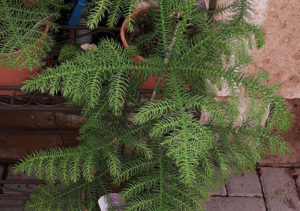 Araucaria heterophylla (Norfolk island pine)
Araucaria heterophylla (Norfolk island pine)
This little tree is especially suitable for smaller chameleons and quite easy to care for. As the Norfolk island pine likes it cooler, it can be used especially for animals that need a cooler hibernation or strong night temperature drops. It can’t stand too warm temperatures.
![]() non-poisonous
non-poisonous
A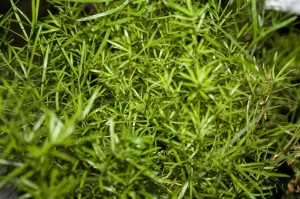 sparagus densiflorus (Asparagus fern)
sparagus densiflorus (Asparagus fern)
A proliferating, light and frugal plant that is particularly suitable for small chameleons or young animals (it will not carry larger ones). Asparagus grows very quickly when well lit, water droplets remain in the narrow leaves for a long time. Some varieties have thorns, which usually don’t bother chameleons. Altogether an easy to care for plant.
![]() contains saponins
contains saponins
Asparagus setaceus (Asparagus fern)
The same applies here as for Asparagus densiflorus. Asparagus setaceus is the softer, much finer-leaved variant of the Asparagus ferns. It is very suitable for very small chameleons or young animals and resembles a bit the Mauritius spleenwort.
![]() contains saponins
contains saponins
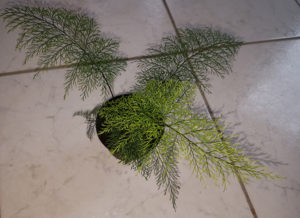 Asplenium daucifolium (Mauritius spleenwort)
Asplenium daucifolium (Mauritius spleenwort)
A plant that grows similar to Asparagus fern and is also only suitable for young animals or small chameleons. In contrast to the former, however, the Mauritius spleenwort is somewhat more demanding in care and grows less quickly. It likes shade and high humidity.
![]() non-poisonous
non-poisonous
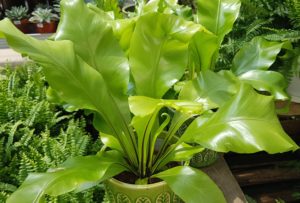 Asplenium nidus (Nest fern)
Asplenium nidus (Nest fern)
Nest ferns grow in Madagascar in all rain forests and reach impressive sizes of several meters in diameter. They can also be kept in the terrarium (in the smaller version), but they are relatively sensitive. The roots must never become dry, otherwise the nest fern shrinks quickly. He likes it bright, but not too high up in the terrarium – there he dries out too quickly.
![]() non-poisonous
non-poisonous
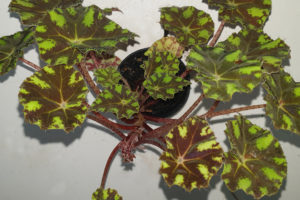
Begonia bowerae (eyelash begonia)
With its pretty purple-green colored leaves and hairy stems, the eyelash begonia catches the eye directly. It grows to a maximum height of 30 cm and is therefore especially suitable as a cover for small terrariums. Originally, the eyelash begonia comes from Mexico. In the terrarium, it wants to have constantly moist roots. With dry roots, it will wither quickly.
![]() contains oxalic acid, calcium oxalates and leucoanthocyanins
contains oxalic acid, calcium oxalates and leucoanthocyanins
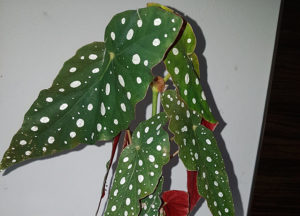 Begonia maculata (Polka dot begonia)
Begonia maculata (Polka dot begonia)
This pretty plant has large, wavy green leaves with white dots on them. An eye-catcher in the terrarium, but only suitable for larger cages as privacy screen. With good care and a bright location, it grows quickly. This begonia must never get dry roots, then it shrinks quite quickly. Well maintained, it regularly gets large, white inflorescences.
![]() contains Ca-oxalates and oxalic acids
contains Ca-oxalates and oxalic acids
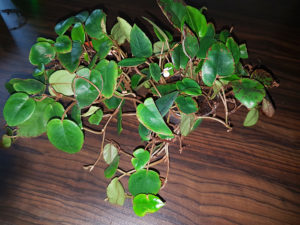 Begonia schulzei
Begonia schulzei
A plant with small leaves, which grows nicely through the terrarium with good care and forms pretty, but tiny pink-white flowers all year round. Grows moderately fast and is best placed in a pot on the back wall in the middle area of the terrarium.
![]() non-poisonous
non-poisonous
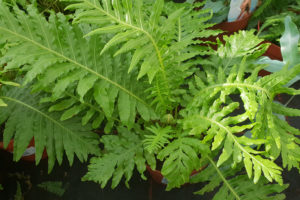 Blechnum gibbum (tree fern)
Blechnum gibbum (tree fern)
The rib fern is a popular indoor plant, which also cuts a good figure in terrariums. A green thumb is needed to keep the fern alive: High humidity and temperatures above 20°C are suitable for this plant, but the fern fronds should not be sprayed directly. The fern also does not forgive a location too close to the lamp, better it is a little shadier. In winter the fern should be kept cooler (around 15°C).
![]() non-poisonous
non-poisonous
Calathea crocata (Peacock plant)
A plant which has very pretty flowers and is also a nice decoration for the terrarium. It should be placed in the pot in half shade. In winter they should be kept cool if necessary, unless the chameleon also needs a cooler hibernation.
![]() non-poisonous
non-poisonous
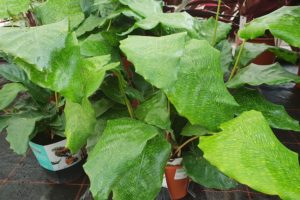 Calathea musaica (Network Calathea)
Calathea musaica (Network Calathea)
This Calathea, like many of her relatives, likes damp soils and semi-shady places at the bottom of the terrarium. It has pretty, broad leaves, finely patterned with white lines. It does not like dripping wet or dried out roots, then it shrinks quickly.
![]() non-poisonous
non-poisonous
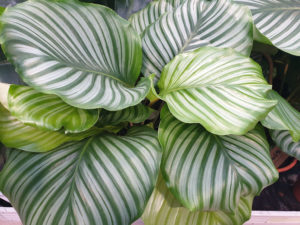
Calathea orbifolia
Another Calathea with very decorative striped leaves. It is not very suitable for climbing, but offers good privacy in the lower third of large terrariums. Like all Calathea it likes humid ground, but no stagnant moisture.
![]() non-poisonous
non-poisonous
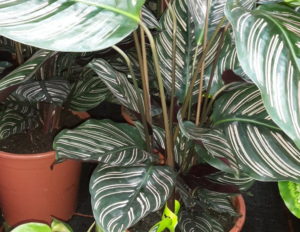 Calathea ornata (Pinstripe Calathea)
Calathea ornata (Pinstripe Calathea)
This plant also has long stems and decorative, large, elongated leaves. They are available with white or pink stripes on the leaves. It also grows well on the ground of larger terrariums and likes moist soil – in the terrarium it is therefore rather easy to care for. It must not dry out.
![]() non-poisonous
non-poisonous
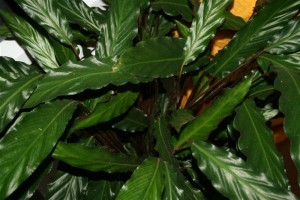 Calathea rufibarba (Velvet Calathea)
Calathea rufibarba (Velvet Calathea)
A medium sized ground plant with elongated leaves, which are soft-haired on the underside and on the stems. If there is a lack of water, the plant rolls up its leaves, so it should never dry out. This plant grows well on the ground even in larger terrariums.
![]() non-poisonous
non-poisonous
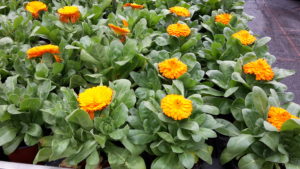 Calendula officinalis (Marigold)
Calendula officinalis (Marigold)
These plants are easy to care for, but only suitable for decoration in the chameleon terrarium. For chameleons that do not spurn plants, the flowers are an attractive food supplement.
![]() non-poisonous
non-poisonous
 Calystegia sepium (Hedge bineweed)
Calystegia sepium (Hedge bineweed)
The allotment gardener knows this plant as an annoying, incredibly fast growing weed. Accordingly, the fence bindweed is a very good climbing plant for outdoor enclosures. In the terrarium it is rather difficult to keep for a long time, but at the beginning it grows quickly and is well suited as a food plant for herbivorous chameleons. In summer, the fence winds form large, white, funnel-shaped flowers that are particularly attractive to herbivores.
![]() non-poisonous
non-poisonous
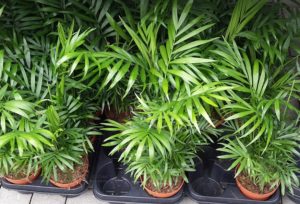 Chamaedora elegans (Parlour palm)
Chamaedora elegans (Parlour palm)
This plant remains rather small and is therefore more suitable for small terrariums. It is not very suitable for climbing because of its long leaves and few supporting stems, but it can serve as a screen. It does not tolerate dryness well, the soil should always be moist.
![]() non-poisonous
non-poisonous
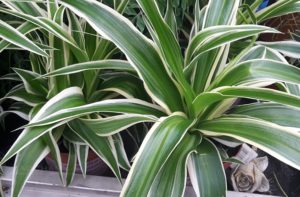 Chlorophytum comosum (Spider plant)
Chlorophytum comosum (Spider plant)
An almost indestructible plant that grows hanging. Spider plants do not mind even long dried out soil, a few leaves die off and with the next watering it grows all the more. In addition, spider plants form long stems with branches on them, which can be simply placed in a glass of water to form roots. Spider plants are not suitable for carrying larger chameleons, but can be used well for greening.
![]() Seeds contain saponins
Seeds contain saponins
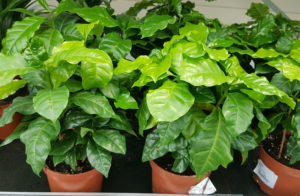 Coffea arabica (Coffee plant)
Coffea arabica (Coffee plant)
Many larger chameleons find good living conditions in coffee plantations, in the terrarium this plant is difficult to cultivate. If you have a green thumb and some luck, however, you can grow a very bushy, growing plant that is well suited for medium sized chameleons climbing. In many nurseries you can also buy small coffee plants, which can then also stand in smaller terrariums because of their slow growth.
![]() Seeds (beans) contain coffein
Seeds (beans) contain coffein
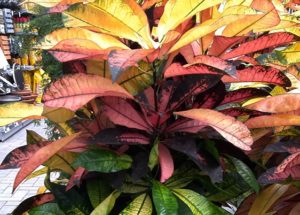 Codiaeum variegatum (Garden Croton)
Codiaeum variegatum (Garden Croton)
The Garden Croton is a pretty spot of colour in the terrarium, especially because of its colourful leaves. It is also easy to climb for medium-sized chameleons and grows quite bushy. But you should have a green hand for this little tree, otherwise it will come in quickly.
![]() contains phorbolesters
contains phorbolesters
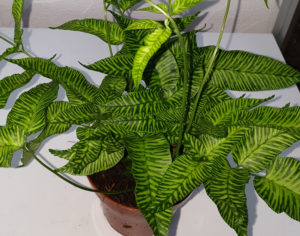 Coniogramme emeiensis (Striped bamboo fern)
Coniogramme emeiensis (Striped bamboo fern)
A very pretty plant with narrow, striped leaves. It grows with rather thin stems, so it is more suitable for decoration than for climbing. Bamboo fern likes to have moist roots at all times and should not dry out. A place directly under a lamp is not suitable for this plant. Some Coniogramme species are poisonous, unfortunately for this species, we have not been able to find any reliable information on toxins.
![]() unknown
unknown
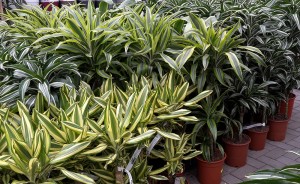 Dracaena ssp. (Dragon tree)
Dracaena ssp. (Dragon tree)
Dragon palms are available in every garden center in different species, some with multi-coloured leaves. All have a long, thin stem and equally long, narrow leaves. They like a bright location, but are otherwise quite easy to care for.
![]() contains saponins
contains saponins
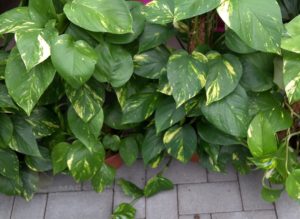 Epipremnum pinnatum (Pothos)
Epipremnum pinnatum (Pothos)
This undemanding plant is standard in almost every chameleon cage. It also covers the upper areas and grows quickly through the terrarium if watered regularly. The thick shoots can be used by medium sized chameleons for climbing.
![]() contains Ca-oxalates and oxalic acids
contains Ca-oxalates and oxalic acids
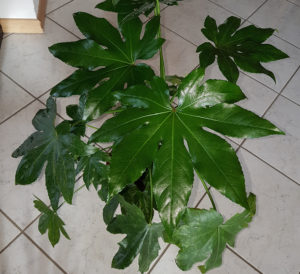 Faszia japonicum (Paper plant)
Faszia japonicum (Paper plant)
This slender, tall plant is suitable as a privacy screen for medium-sized terrariums. It likes it relatively light, and forgives care mistakes such as waterlogging at the roots rather badly. Overall, they should be kept dry. In winter, paper plants should be kept cool if the chameleon in the terrarium does not come from higher altitudes anyway and also needs a cooler winter phase. For chameleons from the south and southwest of Madagascar this plant is not a good choice – such hot temperatures are not suitable for paper plants.
![]() contains saponins
contains saponins
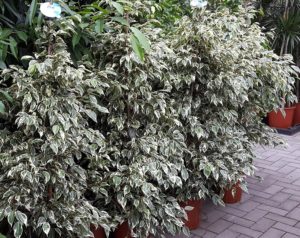 Ficus benjamina (Rubber fig)
Ficus benjamina (Rubber fig)
The standard tree in many chameleon terrariums, but only for non herbivorous chameleons a good choice. Rubber figs grow quickly, densely and can easily be climbed by chameleons. Ficus benjamina will end up shedding of almost all leaves when you change its location, but they will grow back after a while. Basically it is an easy-care plant. From time to time one must cut back the little tree a little so that it does not lose all leaves in the lower area.
![]() contains triterpens and proteases
contains triterpens and proteases
Ficus binnendijkii (Narrow-leaf fig)
Another type of fig, which grows very quickly, but remains rather slender and is therefore particularly suitable for small to medium-sized chameleons. This little tree likes a bright location. As with the rubber fig, the upper parts have to be cut back again and again so that the little tree does not lose its leaves in the lower part.
![]() contains triterpens, furanocumarins and proteases
contains triterpens, furanocumarins and proteases
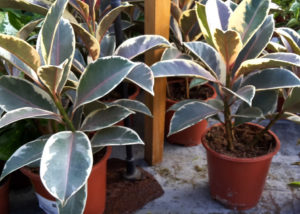 Ficus elastica (Rubber fig)
Ficus elastica (Rubber fig)
A plant similar to Ficus benjamini with significantly larger leaves. This little tree is also popular used in cages, chameleons also like to drink drops of water from it. Otherwise the same applies as with the other rubber figs.
![]() contains triterpens and proteases
contains triterpens and proteases
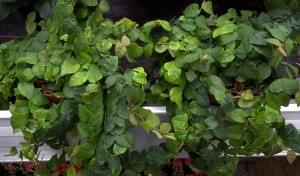 Ficus pumila (Creeping fig)
Ficus pumila (Creeping fig)
This climbing plant is particularly suitable for greening the back walls, as it is neither particularly suitable for climbing nor as a watering place. On the back wall, however, it will green quickly and densely as long as it does not dry out.
![]() contains triterpens and proteases
contains triterpens and proteases
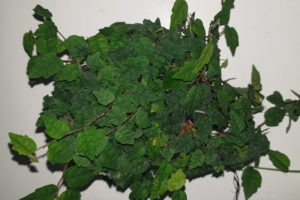
Ficus pumila var. quercifolia (oak leaf ficus)
This variety of climbing fig is also known as Ficus scandens or Ficus quercifolia scandens. However, it is actually not a separate species, but a variation of the creeping fig Ficus pumila. It is named after its small leaves, which are shaped like oak leaves. Ficus montana, whose leaves look quite similar, grows much larger.
![]() contains triterpenes and proteases
contains triterpenes and proteases
Ficus sagittata
This type of Ficus is a climbing vine with larger leaves than Ficus pumila. It comes in a variety with green leaves or with white-green variegated leaves. Both are best in a pot in the middle area of the terrarium attached to the back wall or planted in the bottom in small terrariums.
![]() contains triterpens and proteases
contains triterpens and proteases
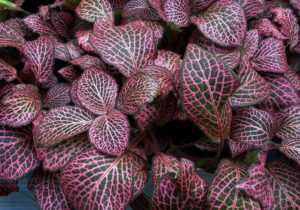 Fittonia albivenis (Nerve plant)
Fittonia albivenis (Nerve plant)
This small plant has pretty, white or purple leaves and is relatively easy to maintain in the terrarium. It is mainly for decoration in smaller terrariums, it is not suitable for climbing.
![]() non-poisonous
non-poisonous
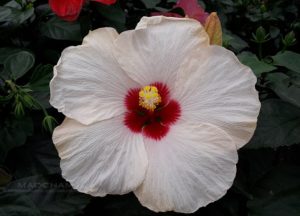 Hibiscus rosa-sinensis (Hibiscus flower)
Hibiscus rosa-sinensis (Hibiscus flower)
In many places Hibiscus is used as an ornamental in gardens, but it is just as suitable for the chameleon terrarium. Larger shrubs carry medium-sized chameleons. The large, colourful flowers are very decorative and an attractive food for chameleons, which are sometimes not averse to eating a plant. Hibiscus is also suitable for outdoor enclosures (tip: there are also winter-hardy varieties that can remain outside in the cold).
![]() non-poisonous
non-poisonous
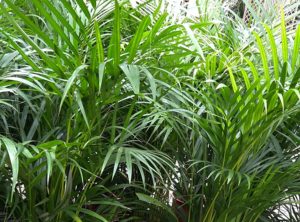 Howea forsteriana (Kentia palm)
Howea forsteriana (Kentia palm)
This plant can be found in almost all garden centres and is less suitable for climbing, but a good privacy screen in the lower to middle area of the terrarium of large species. It should not become too dry and should not hit the gauze on top, otherwise the leaves will burn easily.
![]() unknown
unknown
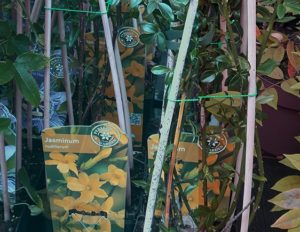 Jasminum officinale (Common Jasmine)
Jasminum officinale (Common Jasmine)
Jasmine is a climbing shrub with pretty, small, white flowers. For small and medium-sized chameleons, the many ramifications offer a good opportunity for climbing.
![]() non-poisonous
non-poisonous
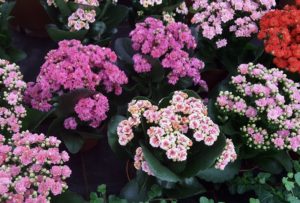 Kalanoche blossfeldiana (Flaming Katy)
Kalanoche blossfeldiana (Flaming Katy)
This thick-leaved plant from Madagascar grows well and quickly in the terrarium, but is more decorative than climbable. In nurseries one gets different colour varieties with purple, white, red or orange flowers, because Kalanchoe is often used as a balcony plant.
![]() contains bufadienolids and cotyledontoxics
contains bufadienolids and cotyledontoxics
Mandevila sanderi (Brazilian Jasmine)
Brazilian Jasmines bloom abundantly and grow very quickly, especially in summer, outdoors in the garden or on the balcony. The plant grows rather shrubby overall and is suitable as a cover for small to medium-sized chameleons. Brazilian Jasmine does not like waterlogging and blazing sun.
![]() non-poisonous (Caution: the milky juice has been found to contain substances that irritate the skin, so this is not a feeder plant!)
non-poisonous (Caution: the milky juice has been found to contain substances that irritate the skin, so this is not a feeder plant!)
 Maranta leuconeura (Prayer plant)
Maranta leuconeura (Prayer plant)
This pretty plant likes it light and indicates if it does get too sunny: It then folds the leaves upwards. The roots must never dry out, otherwise the leaves will curl up. The arrowroot is beautiful as a screen for medium-sized terrariums, but the plant stems do not carry a larger chameleon.
![]() non-poisonous
non-poisonous
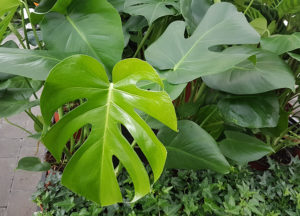 Monstera deliciosa (Fruit salad plant)
Monstera deliciosa (Fruit salad plant)
There are different leaf sizes, so that you can choose the right plant for almost every terrarium size. The leaves have “columns”. The window leaf can also be planted in the bottom of larger terrariums, but is more likely to look for the middle, slightly lighter area. All in all, it is easy to care for.
![]() contains Ca-oxalates and oxalic acid
contains Ca-oxalates and oxalic acid
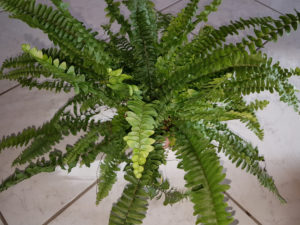 Nephrolepis exaltata (Sword fern)
Nephrolepis exaltata (Sword fern)
Sword ferns grow well groomed for years and can grow quite large. They are suitable as decoration for large terrariums. They are best kept in the middle area, where it is not too dark. The most important thing in the care of the sword fern is to keep its roots constantly moist. Once dry, it dies quickly.
![]() non-poisonous
non-poisonous
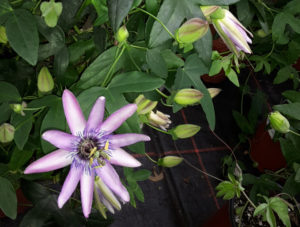 Passiflora caerulea (Passion flower)
Passiflora caerulea (Passion flower)
The passion fFlower is the tip for all those who have empty spaces in the upper and middle area of the terrarium where simply nothing wants to grow. The passion flower grows along all branches very quickly. Its large, purple and white flowers bloom only for one day, but they do so all year round. The only catch is the roots of the passion flower: it must never dry out, otherwise it will shrink very quickly. Passion flowers also grow very well in Madagascar, even if they do not occur there originally.
![]() contains alcaloids
contains alcaloids
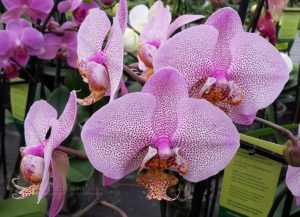 Phalaenopsis ssp. (Moth orchid)
Phalaenopsis ssp. (Moth orchid)
These pretty plants are orchids that are also suitable for ambitious beginners in orchid care. Meanwhile they can be bought in garden centres in all possible colours and crossings. They bloom only once a year, but then all the more decorative. In the terrarium they are best placed in the middle up to the top. It is important that they never get wet feet, only sprayed on.
![]() non-poisonous
non-poisonous
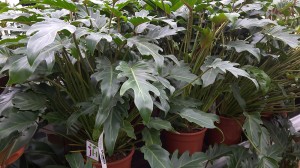 Philodendron erubescens (Split leaf)
Philodendron erubescens (Split leaf)
An easy-care, fast-growing plant. There are different leaf shapes and colours. The tree lover is more decorative than suitable for climbing.
![]() contains oxalic acids
contains oxalic acids
Phlebodium aureum (Blue star fern)
This fern can be epiphytically tied to branches, cared for, as well as potted in soil. The golden spotted fern likes it warm and semi-shady. Directly under a terrarium lamp it does not feel well. The fern tolerates regular watering well, but with permanently wet roots it is very sensitive.
![]() non-poisonous
non-poisonous
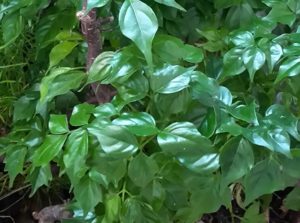 Radermachera sinica (China doll)
Radermachera sinica (China doll)
This plant is a wonderful shrub-like plant for small and medium-sized chameleons (depending on growth size). It grows densely, has countless small but supporting branches and looks very decorative in the terrarium. The leaves hold water quite well, and in addition the carp ash is quite easy to care for. An ideal shrub for chameleons.
![]() non-poisonous
non-poisonous
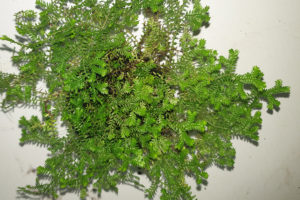
Selaginella kraussiana (Clubmoss)
This plant is best suited as a ground cover in small terrariums, for example for Brookesia species. It needs very moist roots and high humidity to grow well. This can sometimes take a long time (weeks to months). But once the moss fern has “taken root”, it grows well and abundantly. In principle, not very easy to cultivate in the chameleon terrarium.
![]() non-poisonous
non-poisonous
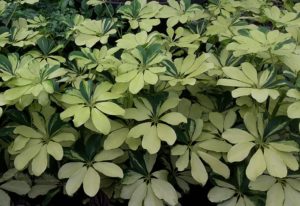 Schefflera arboricola/actinophylla (Dwarf umbrella tree)
Schefflera arboricola/actinophylla (Dwarf umbrella tree)
The dwarf umbrella tree is a good alternative to the ubiquitous figs. It grows quickly, is easy to care for, does not lose its leaves and can be easily climbed by chameleons of all sizes. Besides, water drops get stuck on the leaves.
![]() contains oxalates
contains oxalates
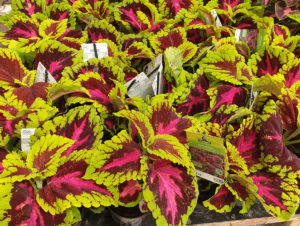
Plectranthus scutellarioides (Coleus)
Coleus are available in many different varieties, most of which are very colourful. The most beautiful colours are formed by this plant under natural sunlight. It is a nice terrarium decoration, but does not grow very fast and carries at most very small chameleons.
![]() contains diterpens
contains diterpens
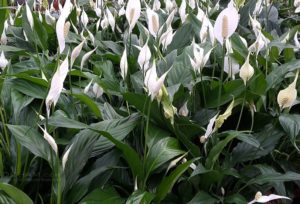 Spatiphyllum wallisii (Peace Lily plant)
Spatiphyllum wallisii (Peace Lily plant)
This plant has long, shiny leaves and beautiful, large, white flowers that can be found in shady areas of the terrarium. It cannot be climbed, but it is easy to care for and decorative.
![]() contains oxalic acids
contains oxalic acids
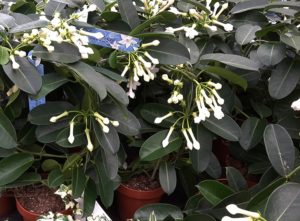 Stephanotis floribunda (Madagascar jasmine)
Stephanotis floribunda (Madagascar jasmine)
A climbing plant from Madagascar that develops very long shoots. It grows slowly and should not dry out. From time to time the wreath loop develops small, white flowers. Its shiny dark green leaves hold water drops very well.
![]() Poisons are assumed or proven, but there exists no published case of poisoning
Poisons are assumed or proven, but there exists no published case of poisoning
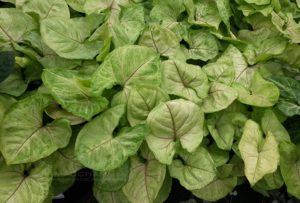 Syngonium podophyllum (Goosefoot plant)
Syngonium podophyllum (Goosefoot plant)
Similar to Pothos, this is a climbing plant whose tendrils are thick enough to carry a medium-sized chameleon. Nurseries offer different leaf colours. All in all, it is quite undemanding and easy to cultivate.
![]() contains Ca-oxalates and oxalic acid
contains Ca-oxalates and oxalic acid
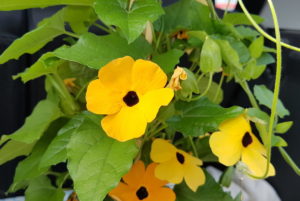 Thunbergia alata (Black-eyed Susan vine)
Thunbergia alata (Black-eyed Susan vine)
A great climbing plant with pretty yellow and orange flowers for the outdoor enclosure in summer. This plant needs branches or a little tree to climb it. It likes it sunny and airy on the balcony or in the garden, but must not dry out.
![]() non-poisonous
non-poisonous
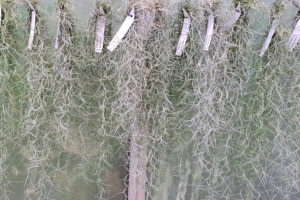 Tillandsia usneoides (Lousiana moss)
Tillandsia usneoides (Lousiana moss)
This plant, also known as “beard”, grows purely epiphytically, i.e. it does not drive out roots. You hang it on a small wire, it is maintained with direct spraying once a day. It turns dark green then. The flowers are tiny and barely visible. A nice decoration for chameleon cages. If you want to maintain the moss for a long time, you should put it once a week for ten minutes in a container with water, so that it can soak up properly, and then hang it back into the terrarium.
![]() non-poisonous
non-poisonous
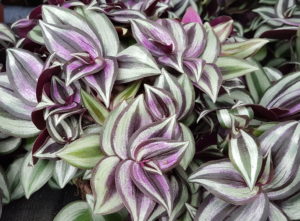 Tradescantia zebrina (Inchplant)
Tradescantia zebrina (Inchplant)
This herbaceous plant grows very quickly and has pretty striped, purple leaves on the underside, but is quite sensitive. At the lowest load, the shoots break off, but can then simply be put back into the soil and sprout again. It forms small pink flowers all year round. A pretty plant for easy-care terrarium decoration.
![]() contains irritants, eventually Ca-oxalates
contains irritants, eventually Ca-oxalates
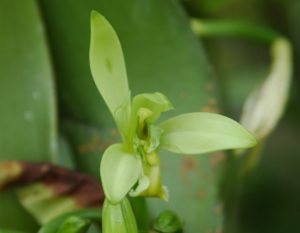 Vanilla planifolia (Vanilla plant)
Vanilla planifolia (Vanilla plant)
Vanilla is an orchid grown in large plantations on Madagascar’s east coast. In the terrarium it is quite demanding and forgives a few mistakes. Well cared for, it ranks along other plants towards light and forms large, yellow flowers once a year.
![]() Pods contain vanillin
Pods contain vanillin

